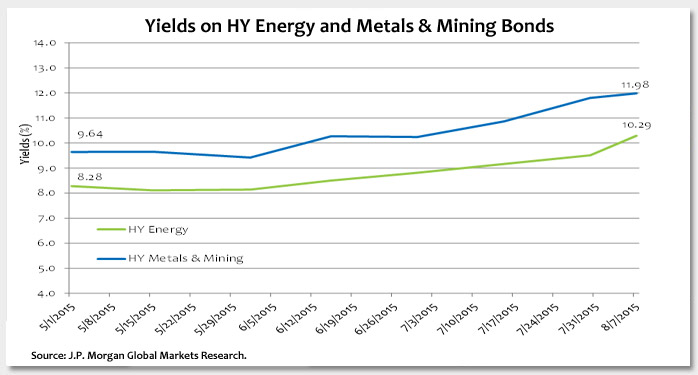It has been a horrible few months for the commodity complex (oil, natural gas, met coal, thermal coal, copper, aluminum, steel, gold, etc.), as price declines have led to significant equity and bond market underperformance. The pain has been particularity acute in the high yield credit market, where a majority of energy and metals/mining bonds are down 10 to 40 points since May. These two sectors are the only two negative returning industries in the JP Morgan High Yield Bond Index this year.
The default cycle has already started. The energy and metals/mining sectors represent about 70% of default and distressed exchange volume in 2015 and account for over three quarters of the high yield universe trading below $70, which is considered distressed-level bonds. According to a recent Morgan Stanley report, the market-implied 5-year cumulative default rate for high energy companies is about 30%. While many companies have adequate liquidity into 2018, and management teams have aggressively reduced capex and operating costs, the market is discounting low oil and natural gas prices for an extended period of time. Moreover, future recovery rates are being impacted by recent second lien bond deals, which subordinate unsecured note-holder claims, and there are expectations for more to come.
During the first quarter of 2015, oil appeared to find a bottom and started to grind higher. While still down 50% from its peak, the idea of stabilization caused the market to rally. However, after peaking in the low $60s in May, the price of oil has subsequently declined 25%, mainly due to weakness in China and nervousness over the Iran nuclear deal. Also, despite an almost 60% decline in oil rig count over the last year, domestic production remains stubbornly high as companies reduce costs, increase productivity, and tap additional liquidity sources.
In addition to the recent pullback in oil, two other factors appear to be influencing bond prices - investor fatigue and positioning. Sentiment is washed out, particularly after the first quarter's head-fake trade, and many buy-side firms already own a lot of energy paper. With buyers now having more limited investment capacity, bond prices react severely when larger holders attempt to pare their exposure.
Key Takeaway: Trying to call a bottom on oil prices feels a lot like trying to catch a falling knife. It's likely to be painful no matter where you grab it, so deciding when to grab can be tricky. I was nibbling on what I perceived to be higher-quality high yield energy at the beginning of the year, and what looked to be a good move in the first quarter now looks premature. Still, I feel there is value in some of these credits yielding over 7% and think a number of them can survive with oil in the $45-55 range.
The material provided here is for informational use only. The views expressed are those of the author, and do not necessarily reflect the views of Penn Mutual Asset Management.
This material is for informational use only. The views expressed are those of the author, and do not necessarily reflect the views of Penn Mutual Asset Management. This material is not intended to be relied upon as a forecast, research or investment advice, and it is not a recommendation, offer or solicitation to buy or sell any securities or to adopt any investment strategy.
Opinions and statements of financial market trends that are based on current market conditions constitute judgment of the author and are subject to change without notice. The information and opinions contained in this material are derived from sources deemed to be reliable but should not be assumed to be accurate or complete. Statements that reflect projections or expectations of future financial or economic performance of the markets may be considered forward-looking statements. Actual results may differ significantly. Any forecasts contained in this material are based on various estimates and assumptions, and there can be no assurance that such estimates or assumptions will prove accurate.
Investing involves risk, including possible loss of principal. Past performance is no guarantee of future results. All information referenced in preparation of this material has been obtained from sources believed to be reliable, but accuracy and completeness are not guaranteed. There is no representation or warranty as to the accuracy of the information and Penn Mutual Asset Management shall have no liability for decisions based upon such information.
High-Yield bonds are subject to greater fluctuations in value and risk of loss of income and principal. Investing in higher yielding, lower rated corporate bonds have a greater risk of price fluctuations and loss of principal and income than U.S. Treasury bonds and bills. Government securities offer a higher degree of safety and are guaranteed as to the timely payment of principal and interest if held to maturity.
All trademarks are the property of their respective owners. This material may not be reproduced in whole or in part in any form, or referred to in any other publication, without express written permission.


